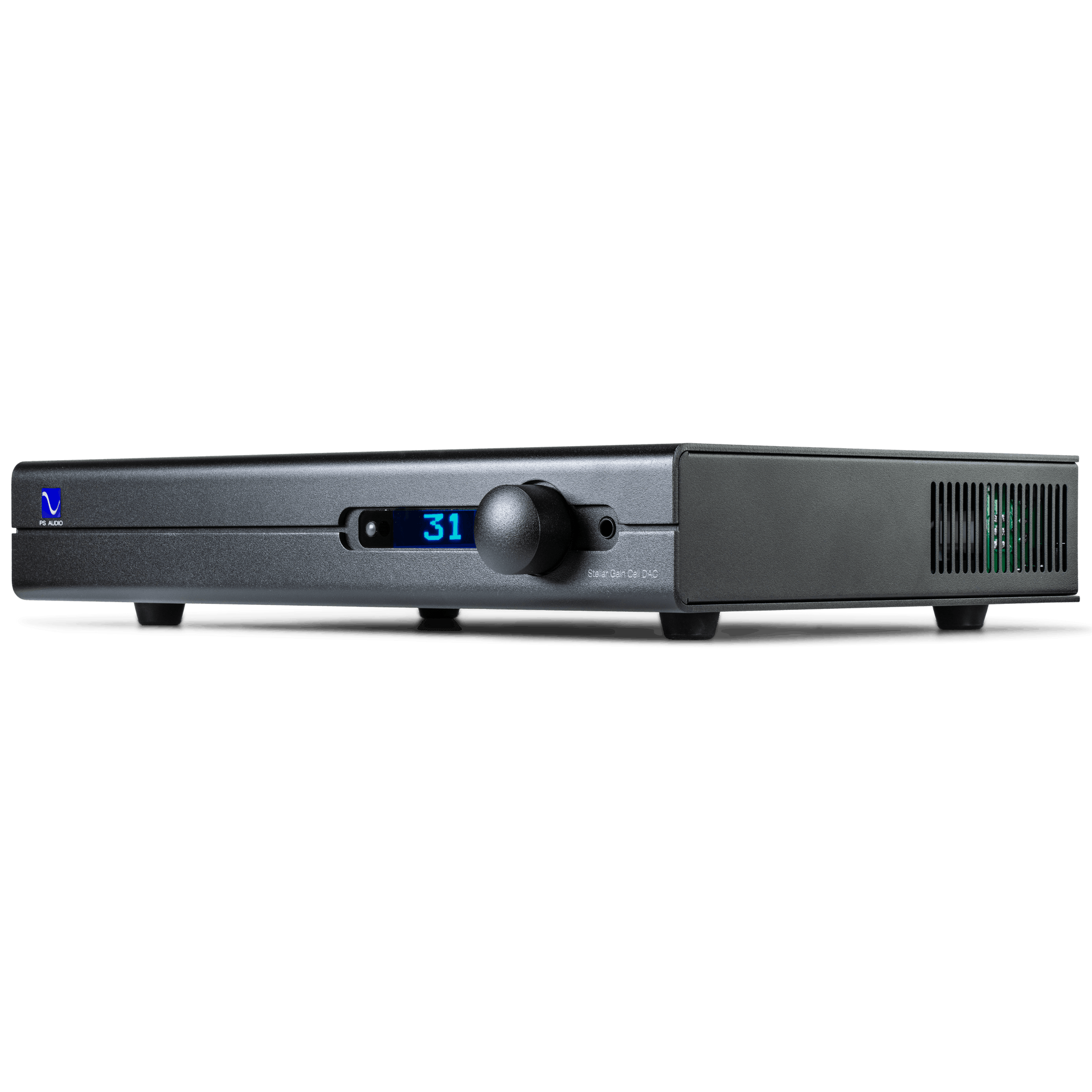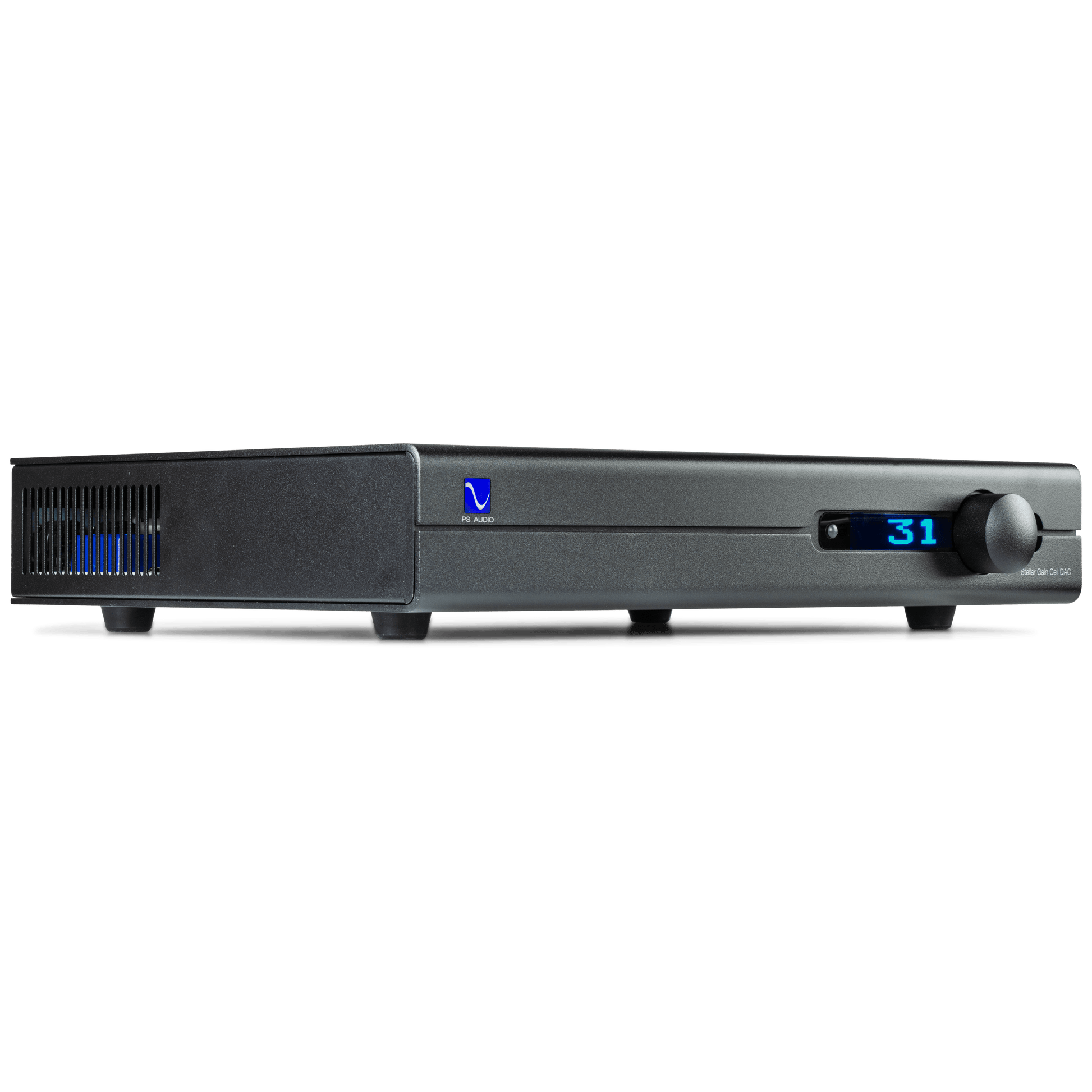GainCell DAC
GainCell DAC
The Stellar GainCell DAC combines the benefits of an exceptional analog preamplifier and a full-featured DAC. It's affordable excellence.
The analog preamplifier is the heart and soul of any high-performance audio system. It's the point in a system where music's magic can be won or lost. For more than 45 years, PS Audio has been building preamplifiers that honor the music and preserve the magic. The Stellar Gain Cell DAC is no exception. It features fully balanced class A analog circuitry from input to output, along with a state of the art DAC that ensures perfect symmetry between analog and digital. Rediscover the wealth of music in your library, with Stellar. Rich, sweet, and always a musical treat, Stellar GainCell DAC is our best value in bringing life to music.
This product is only available through a dealer in your area.
Couldn't load pickup availability

TALK TO A HI-FI SPECIALIST


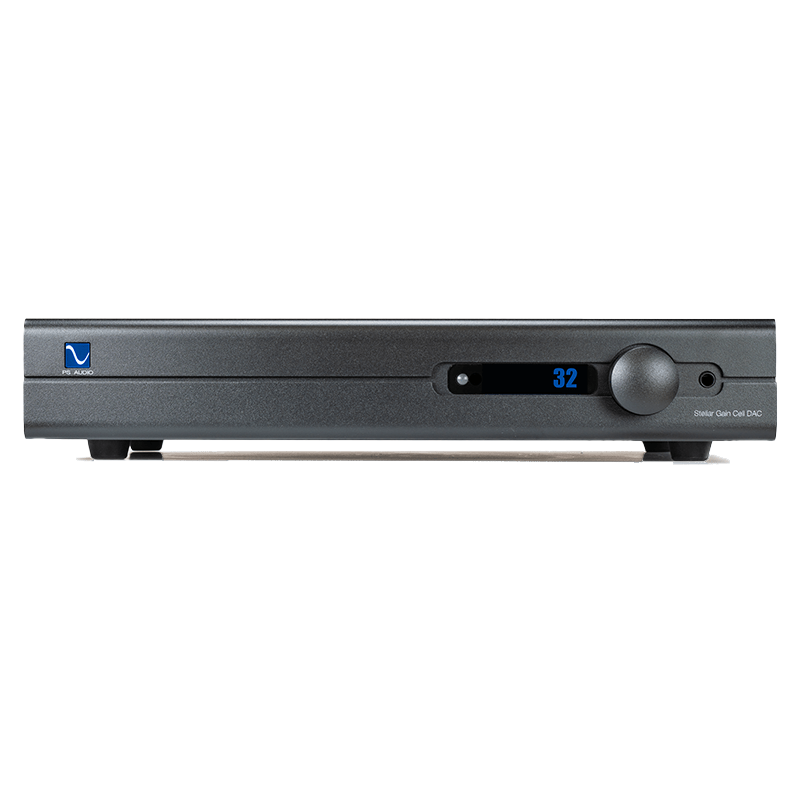
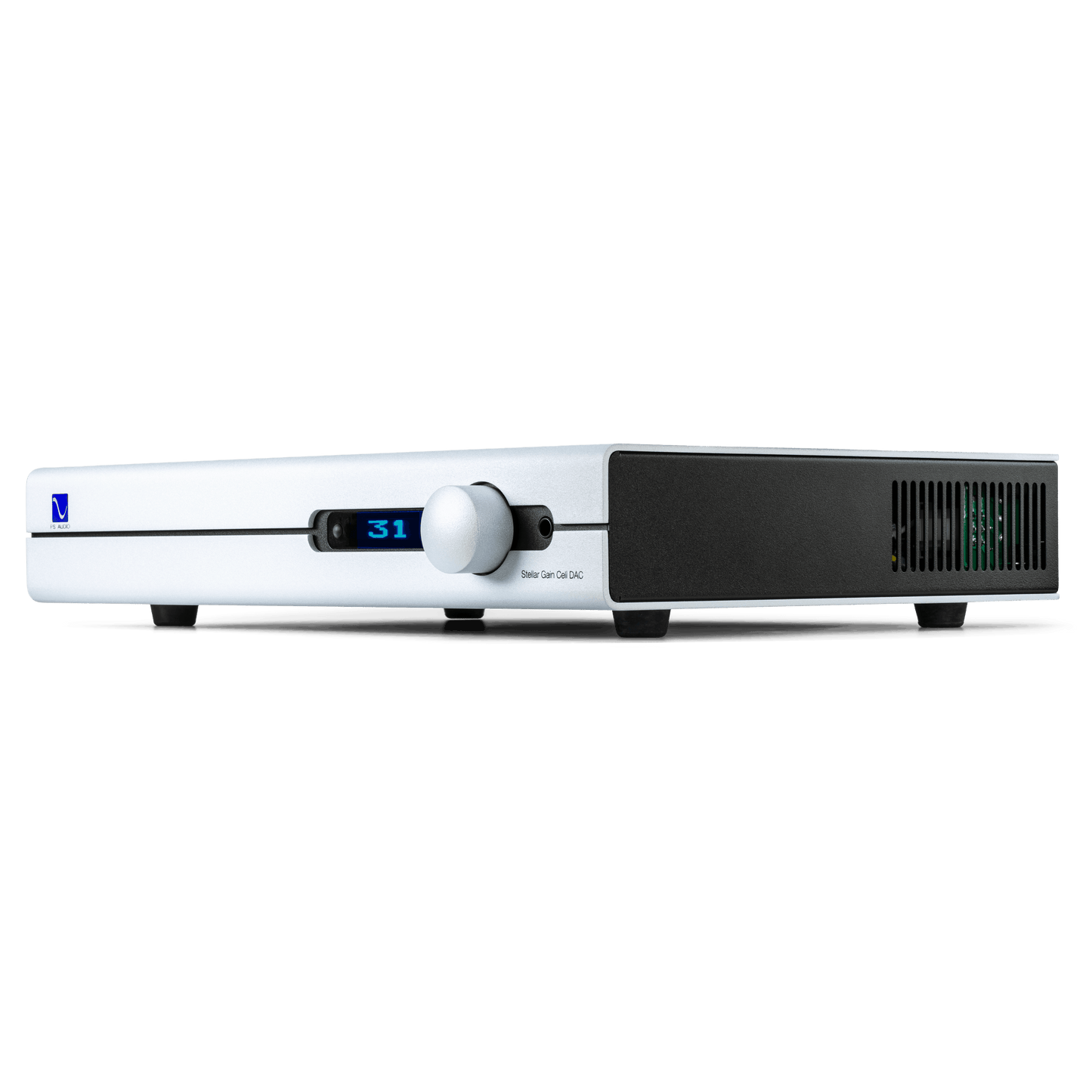




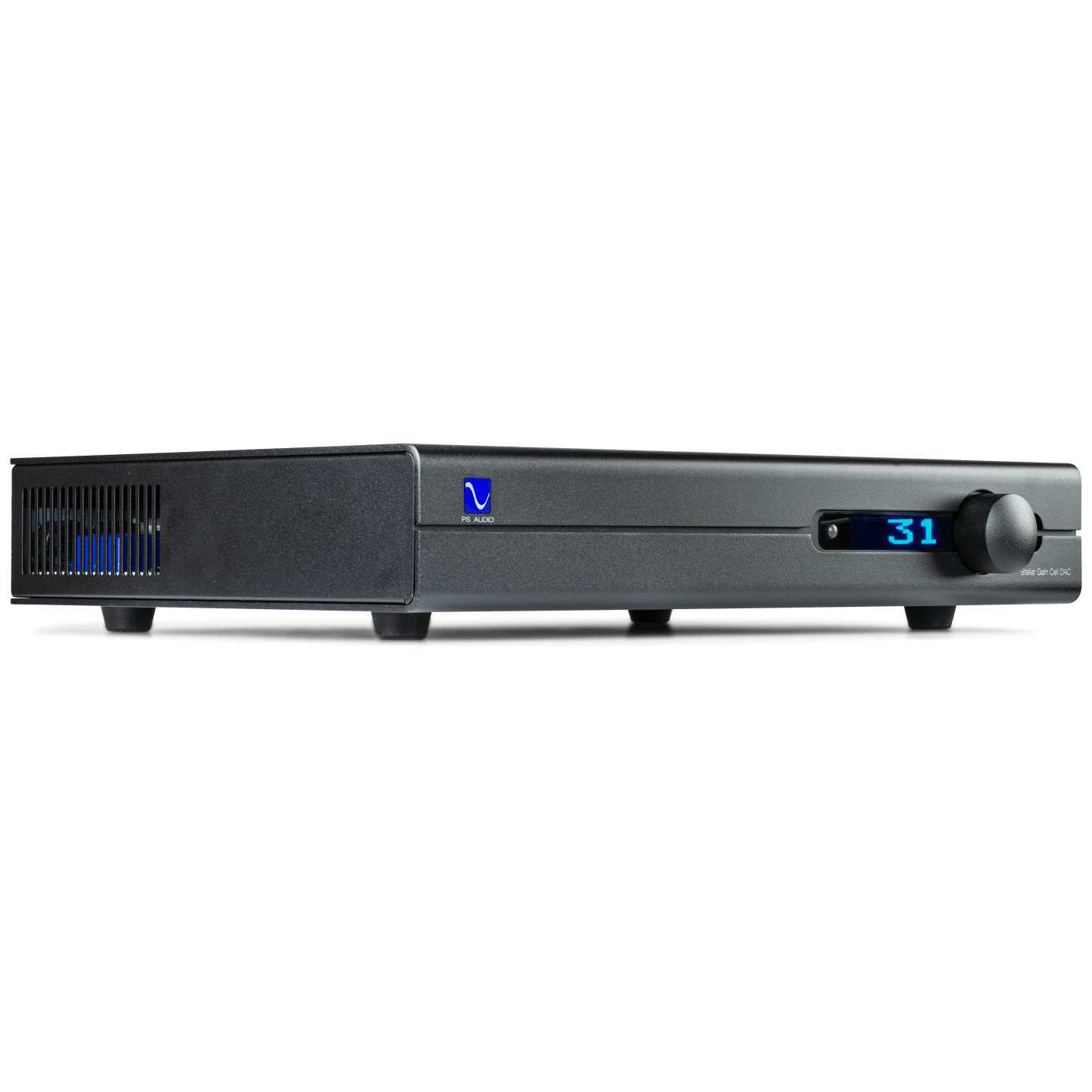



-
Design
-
Application
Technology



Features
Specifications - Gaincell DAC
Physical |
|
| Unit Weight | 13.5 lbs [6.1 kg] |
| Unit Dimensions | 17” x 12” x 3” |
| Shipping Weight | 17 lbs [7.7 kg] |
| Shipping Dimensions | 23”x 18” x 9” |
Power requirements |
|
| Input Power | Model specific 100VAC, 120VAC, or 230VAC 50 or 60Hz |
| Power Consumption | 20W |
| Mains Power Input | IEC C14 |
| Fuses | 100V T250V-2.0AH (2A Slow Blow) 120V T250V-1.6AH (1.6A Slow Blow) 230V T250V-1.0AH (1.0A Slow Blow) |
| Accessories included | US (NEMA 5-15P) (all versions) Schuko (CEE7/7) (230V version) UK (BS1363) (230V version) |
Analog inputs |
|
| RCA XLR |
3 stereo pair 1 stereo pair |
Digital audio inputs |
|
| I2S | 1 PCM (384KHz max) DSD64 DSD128 Compatible with DirectStream Transport SACD handshake for DSD playback |
| Coax | 2 PCM (192KHz max) |
| Optical | 1 PCM (96KHz max) |
| USB | PCM (384KHz max) DSD64 (DoP) DSD128 (DoP) |
| Format | PCM, DSD |
Analog Audio Outputs |
|
| RCA XLR Headphones |
(Analog Unbalanced) 1 stereo pair (Analog Balanced) 1 stereo pair One 1/4" headphone connector front panel |
Analog Performance |
|
| Gain Maximum output Sensitivity |
12dB +/-0.5dB 20 Vrms 5.3Vrms |
| Input Impedance | 47KΩ single ended RCA 100KΩ Balanced XLR |
| Output Impedance | 100Ω single ended RCA 200Ω balanced XLR |
| Frequency Response | 20Hz – 20KHz +0/- 0.25dB 10Hz – 100KHz +0.1/-3.0dB |
| Noise | 20-20KHz <-90dBV |
| S/N Ratio | 1KHz >110dB (max output) |
| Channel separation | 1KHz >90dB |
| Input separation | 1KHz >90dB |
| THD&IM | 1KHz < 0.025% 20-20KHz < 0.05% |
Headphone performance |
|
| Output power @1% THD | 300Ω 300mW 16Ω 3.25W |
| S/N Ratio 1kHz Noise |
>95dB (max output) <-80dBV |
| THD & IM 1Vrms out | 300Ω <0.05% 16Ω <0.06% |
| Output impedance | <4 Ω |
Features |
|
| Volume Control | 0-100 (1/2 and 1dB steps, 80dB total range) |
| Balance Control | 24dB each direction in 1/2dB steps |
| Home Theater Mode | Assignable to any analog input Adjustable (in setup) to any level |
| Polarity (phase) Control | Digital sources only |
| Filter Control | 3 selectable digital filters (PCM digital sources only) |
| Trigger output | (3.5mm 5-15VDC) 2 |
| Remote Control | Yes. Infra Red |
Reviews
Significant improvement
I find music I am familiar w/ significant improvement all aspects of the sound, instrument separation is
better, I am not setting the volume so high (I believe the Gain Cell is responsible for this) The VPI is the
star of the system. There are sounds in the grooves of my lp's that have suddenly emerged. Dave Brubeck,
Robert Glaspher, Donald Fagen, Steely Dan, Snarky Puppy, Stan Getz, Chuck Mangione, Allman Brothers are
being rediscovered.
- Swb1509
Awesome!
Sitting here listening to the 72-hour-old GCD playing Fragile from the Kenny Barron Trio. Served up via Roon
and upsampled to DSD128.
There is a lot going on in this track between the piano, bass, and drum kit. I can hear and differentiate it
all. Precise, deep soundstage. I can hear drummer Victor Lewis' light cymbal and snare taps clearly, and
they are coming from the right place. Awesome.
- Spons
In the room!
The piano was as close to “in the room” as I have heard here. The SACD version of the same album was very
good….but, missing some of the clarity that the GCD imparted to the plain old red book CD. The difference, I
think, is which DAC is doing the DACing here. The Essence is upsampling LPCM 88.2 to 192K, then pushing it
through whatever DAC is in there. The analog preamp part of the GCD is doing a great job with what it is
getting from the Essence, but, I have to say, the red book CD version using the GCD DAC and preamp sounds
better than the SACD through the Essence DAC thence to the GCD preamp section. This is depressing, given
what I had hoped for from SACDs…..but, gives me inspiration to, someday, get a transport that will feed
native DSD to my GCD.
- Calord
Wide sound stage
My impression of the SGCD's sound is that it's very realistic; it provides thick and powerful vocals,
detailed sound, and makes me feel like I'm on a wide sound stage. I listened to “Norah Jones – Come Away
With Me -Don't know why” (FLAC:192khz/24bit); The vocals are focused at the center and are coming more
forward. Each instrument is well separated. I also tried the DSD file “Bill Evans – Some Other Time – Some
Other Time” (DSD 5.6Mhz): the sound was very smooth and relaxing. The sound is detailed but it is not the
kind of that sound that makes you tired after 10 minutes. I also tested with SACD – “Tchaikovsky - Symphony
No. 6; Nutcracker Suite” (conducted by Seiji Ozawa). It gives a much better, fuller sound stage than when I
connect directly to my integrated amplifier.
I was already pleased with the sound of the Nuwave DSD DAC, but am now more pleased than ever with the
amazing quality of the SGCD DAC with its fantastic quality pre-amplifier. As I mentioned in my earlier post,
the DAC is also a great fit in my household due to its slick appearance and convenient features (backlit
volume display, remote, etc). Many thanks to the PS Audio team for another amazing product.
- Rio
Stellar!
So far so good! I'm only 75 hours in and I'm absolutely loving my Stellar Gain Cell Dac!! Expansive
soundstage, beautiful dynamics, crisp and warm, musical sounding, detailed, sharp looking in black with a
gorgeous display, and able to expertly handle everything I've thrown at it. From Seal to Chopin, Hebie
Hancock to Bach Solo Cello Suites, Adel to the Beatles, and the Who to Frank Sinatra, it all sounds amazing.
Voicing of every source is equally well implemented. Streaming, cds and vinyl each sound, well in a word,
“Stellar”. Did I mention I love it!!!
- Corsentino
I am keeping it!
So, how does the Stellar GCD's DAC function compare to either the Benchmark or Light Harmonics Pulse? The
Benchmark always struck me as being a slightly less dynamic and easy to listen to, with ever-so-slight
hardness in the midrange compared to either the older PS Audio Perfect Wave DAC or the PS Audio Direct
Stream DAC that replaced it. Regardless of the Stellar GCD's shortcomings noted above, it is still better
than the Benchmark DAC 2.
With the LH Pulse, the comparison is more nuanced. Light Harmonics exceeded expectations when they came out
with the LH Pulse DAC. Honestly, I've never owned a better DAC under $2K. I've now spent a few hours going
back and forth between the Stellar GCD and the LH Pulse. (I've got the LH plugged into the second set of
analogue single-ended inputs, so I simply move the coax cable from one unit to the other and switch inputs
on the GCD.) Maybe, just maybe, there's a little bit more air in the LH presentation, maybe a little more
ease, I think—and then I play the same content on the Stellar GCD and say “nah, couldn't be! This sounds
great!” So, I'd say the Stellar GCD is virtually neck-and-neck with the LH Pulse S. That is high praise!
As a package, then, the Stellar GCD gives you a preamp that sounds fantastic for the price, and also a DAC
that sounds fantastic for the price! One chassis, no additional interconnects needed, as simple to operate
as anything you might already own. It's a tremendous value, and a component that will give deep musical
satisfaction. Yes, I'm keeping it!
- mggm56
Flawless!
Preamp quality: the Preamp function is flawless with 100 very fine steps that change at a slow but
reasonable speed when the remote volume up/down button is held down. My other preamp is a Hattor active
preamp from poland with dual burson supreme sound v5 opamps which also has 12db of gain and a balanced 64
step resistor based attenuator controlled by relays to only put 2 resistors in the path at once. The gain
cell dac was just as transparent as the Hattor, which is known for transparency and perfect left/right
volume balance due to the precise resistors used for attenuation. The Gain Cell dac includes more inputs and
outputs and this versatility is appreciated vs the smaller Hattor. In general I prefer the gain cell dac's
preamp to my Hattor which is a high compliment as the Hattor is audiophile minimal in design and is a two
box design with a seperate linear regulated power supply box.
Headphone amp quality: A real bonus that should be advertised more. This headphone amp is superior to the
Lehmann headphone amp in my Vinshine soekris dac. A step above in all ways but especially bass which can be
a little loose and slow with the Lehmann using my HD800. It was as good as the Schiit Jotunheim I borrowed
using the single ended 1/4" jack on the Jotunheim.
- Uncola
I'm a bass whore
Typically, in my experience, with an increase in the top-end, comes the dreaded increase in the upper
mid-range also. Like most people, my ears are able to hear the 3k-5k frequency quite easily, and listener
fatigue can set in when this frequency range is too present. With the Stellar Dac, this part of the
mid-range is not over-bearing at all. It is very natural sounding to me. Voices are clear but not edgy.
Trumpets and violins don't get shrill. I'm really happy with the mid-range signature of the Dac.
I'll admit, I've got some "bass-whore" in me. I like a good amount of defined, punchy, accurate bass.
Without it, I lose interest in most any type of music. It's what I listen for at the beginning of seemingly
every song I listen to. If Bob S. and Paul M. didn't get this right, this Dac would be a "Fail" for me.
Luckily, I feel they nailed the signature of the bottom-end, also. It is deep and low without bloat. It has
good definition. Like the mids and highs of the Dac, the low-end is superb. Actually, the bass is quite
musical. To say the Stellar Dac is musical in the bottom-end specifically, is quite a compliment, since that
area of the frequency range has to be fleshed out properly in order to be musical, while not effecting the
mid-range negatively.The Dac is able to present plenty of quality low-end without sacrificing the critical
mid-range. I'll bet most Dacs in this price range can't pull this off.
Synergy-wise, the Stellar Dac does a heck-of-a-job in my system. I feel the Dac is able to convey the mood
of the recording that it's asked to reproduce - and does it effortlessly. I use a computer front end and
bi-amp my Eggleston Works Andra IIIs with QSC class A/B amps. The sound is lively and engaging. The sound
stage doesn't "cry uncle" and collapse or get jumbled-up when the volume goes up to reference level and
beyond. It remains wide and accurate, and the performers keep their individual space up in the front of the
listening room. When Mark Knopfler sings "Wherever I Go" with Ruth Moody, they are now split up a bit, and
side by side, as they perform in the center of my sound stage. They no longer somehow occupy the same space,
defying the laws of physics. I'm guessing that all the attributes of this Dac are, at the foundation,
stemming from a properly designed and implemented power supply. To be quick, musical, and controlled at the
same time takes some good engineering. I'm impressed. This Stellar Dac has found a good home.
- Whymustidothis
Unbeatable!
With any good recording, my system will energize the room with instruments placed front, back, and side to
side from my listening chair. The Oppo did a good job with this effect, in general, but I was sometimes
having to work to see the images in the sound field. (this was using the HDCD decoding in the Oppo). Next I
switched to the Stellar DAC and sat down to listen. On the very first hearing the GCD had impressive imaging
of instruments with very good instrument localization and air. It also had very good frequency extension at
both ends of the frequency range. The imaging was improved over the Oppo, with easier to resolve instrument
placing in the sound field, and a more realistic and solid image outlines. I did not have to work as much to
perceive the instrument's location and I felt a better connection with the music on the GCD. I felt like the
GCD had better realism that allowed me to get sucked into the music and forget the outside world for a
while. For me, this is my acid test of a playback system.
- Mike
A revelation
Regarding true live and non-reinforced performances; the venue doors swing open and you enter, it is almost
a revelation. The lack of anything between you and the musicians, their instruments, is like waking up from
a nap in the sun. It is bright, clear, resolute. This Dac-Pre recreates these experiences. The Stellar gives
you that cooler day, sparkling clarity, cold when you take a deep breath…and dry…not thick or warm. This is
a day you could see for miles and miles. This is the clarity the Stellar is capable of, extreme resolution,
deep into the music, stable images, extreme placement of performances.
- L Couplin
This is going to be fun!
I've listened to a couple of albums now (via JRiver as described above). The sound is already coming alive…
in fact, it's faaaantastic! I'm currently listening to Robert Cray, Strong Persuader (high rez FLAC file).
The detail and punch are just what they should be. His voice is clear and centered, surrounded by nicely
balanced treble and bass. Another wonderfully engineered recording and the Stellar GCD shows it off in fine
fashion. The clarity has improved and the veil has lifted. Wow, this is going to be fun!
- Gene
A keeper!
To cut to the chase - the GCD is a keeper. My one-word lasting impression is: S W E E T. This thing is SOOO
easy to listen to. There's oodles of detail, but always presented in an effortless way that the NFB can't
quite capture. The GCD is also superior in how it portrays the soundstage. It's bigger than the NFB-28 and
every bit as dynamic. Most of my listening was done comparing the GCD via the PWT through the I2S input, vs.
a standard digital coax to the NFB. Granted, this puts the NFB at a disadvantage, but why wouldn't you want
to take advantage of the best connection between the two PS units? When I used the same coax to the GCD, the
differences between them were smaller. However, I still preferred the GCD's sound
- Windowman
It's just better, plain and simple
After swapping the Pioneer SA-8500 for the Stellar GCD I sat down and pressed play and set the volume on the
Stellar GCD, closed my eyes once again. I couldn't believe that "One" could sound even better. It's just
better, plain and simple. Stellar made the music come to life even more. Everything you want to be better
when you're listening to music was better. Throw out any audiophile adverb and whatever it is, it was
improved. I'm not using balanced XLR cable connections or audiophile power cables or even a power
conditioner. These are gold plated Parts Express RCA connections and copper speaker wires, nothing special.
I have to say my favorite track is Fiona Joy. I can see the hammers hitting the strings with each note,
amazing. The snare on track two, wow!!! I can literally reach out and touch that snare at the end of my
ottoman. How??? I'm in love! I threw in Nils Lofgren next of course. I personally like Some must Dream
better than Keith Don't Go. On the Stellar GCD the separation of the two guitars was more separate. The two
voices were more separated also. I could pinpoint their locations better. Even CD's that aren't "great"
recordings were "purer"? I could hear things I hadn't noticed before. You can distinguish between each
instrument and voices so much better, clearer I guess. Looking forward to the rest of the evenings this week
to play. I'm also ripping all my CD's to my NAS through my MAC Mini. I'll be plugging that into the Stellar
GCD later this week.
- Troy Baldwin
The PS Audio Stellar Preamp and S300 Amplifier are a couple of the most musical components I've heard in a
long time, especially in solid state, and especially in this price point. What we're really looking for from
our hard-earned dollar is the enjoyment of our music and if this were my current market, I would snatch
these two components up in a heartbeat. PS Audio continues to impress me with their products, their service,
and their attention to detail. The Stellar Gain Cell DAC has certainly forever changed my viewpoint on what
a good DAC can do, and I encourage you to audition this for yourself.
The Shoestring Audiophile
Michael Lawrance
It matters little how well your DAC recreates the original analog signal, if the analog section isn't able
to pass that signal in a musical way…. The real test for a DAC is its performance with 16/44.1 kHz, so I
began with that…. The musicality presented by the combination of the Digital Lens and PS Audio's analog
section was unprecedented, providing a laser flat, neutral tonal balance, with extension deep into the
subsonic as well as the ultrasonic. The detail was such that it produced a huge soundstage with the
individual instruments portrayed separately in their own space, with their own individual timbre and sense
of air. And the musicality was astounding. The PS Audio Stellar Gain Cell DAC works exceptionally well on
every front, as a DAC, as a Preamp and as a Headphone Amplifier. It is extremely linear in tonality, almost
honeyed in musicality, it is one of the most analog sounding DACs I have listened to. Yet the resolution,
even with 44.1 kHz, is so high as to present an epic soundstage. It is extremely forgiving of both hardware
and software… yet it can provide world class performance from high resolution files on reference quality
Headphones. I believe it to be the pinnacle of what can be achieved with a Chip based DAC, and would label
it a reference DAC if not for the fact that PS Audio produces a DAC that they consider to be higher
performance. As a Headphone Amplifier you would be hard pressed to find a headphone that could not be driven
single ended by the Gain Cell, and I am happy to place it among my favorite solid state amplifiers. All in
all, an epic effort and fully deserving of wholehearted recommendation.
Headphone.guru
Gary Alan Barker

All PS Audio components I've encountered (or owned) are incredibly well-built and the Stellar line is no
exception. They have a weight, look and feel that exudes quality belying their sub-$5,000 USD total cost and
puts me in mind of gear I've reviewed costing double this price point. The PS Audio Stellar 'three-fer'
proved itself to sound far more captivating, powerful, lyrical, musical and possess a humanity to its sonic
signature in playback of all types of music than I previously thought a preamplifier and mono blocks priced
under $5,000 USD would be capable of. They would, without fail, elicit both an emotional and physical
reaction whenever I played music through them and their lack of digital pretense and healthy dose of analog
spirit was a listening experience which I embraced.
AudioStream
Rafe Arnott

…I could not fault the sound of the Gain Cell DAC -- its neutrality and honesty were captivating, leading to
compelling listening. During my time with it and the pair of M700s, I always felt they had total control
over whatever music was thrown at them, in whatever format. From the understated nuance of an unaccompanied
lute to the bombast of a symphony orchestra going full tilt, the laid-back drive of dub or the pulse of
electronica, I not once felt deprived of any of the music's emotion, rhythm, dynamics or detail. Whether
using planar, stand-mounted or floorstanding speakers, I knew I would be rewarded with music free of noise,
artifact or boredom. Used together, the Gain Cell DAC and M700s represent an intelligent, cost-effective
entrance into high-end audio's top tier…. “The PS Audio Stellar Gain Cell DAC and M700 mono amps took my
system to a level that, with some recordings, was eerily close to the real thing. Paul McGowan and his crew
in Boulder should be beaming with pride over the superlative performance of these components. Those making a
first purchase or those seeking to upgrade must audition these electronics or risk having spent hard-earned
money foolishly elsewhere.
The Audio Beat
Guy Lemcoe

Speaking of price, there's nothing about the Stellar Gain Cell DAC/Preamp that says under $2k. This holds
for the music it makes which is really great news. Based on my experience, albeit time-worn, I get the
impression that PS Audio likes to make music sound highly listenable through its products. You know, the way
we want it to sound. The Stellar Gain Cell DAC/Preamp commits no digital crimes against music. It is smooth,
well-balanced, and eminently listenable… The preamplifier, as advertised, is very good sounding and there's
no reason not to mate Stellar with your amp-O-choice. Again, I'm not talking about "considering its price",
I'm talking about very good sounding. The same holds for that headamp which made my AudioQuest NightOwls
sing (not screech). Overall, music is presented as nicely round without any glare or etch which can be a
thing when shopping in this price aisle… PS Audio has gone and done it—the Stellar Gain Cell DAC/Preamp
offers more performance than the sum of its part and price might suggest. This translates into a
DAC/preamplifier that serves all of your music well, which should keep you listening for as long as time
allows.
AudioStream
Michael Lavorgna

They sounded so good together I couldn't bring myself to try too many other speakers. The sound was rich
with resolution to die for. Magnepan speakers aren't known for their deep bass punch, but here with the two
Stellars the .7 speakers' low bass was kicking with "The Legendary Skatalites in Dub" reggae album with
really low, feel-it-through-your-toes bass. Austin Wintory's orchestral score for "The Banner Saga" sounded
downright huge, and the low bass drums definition was truly stellar!
C/NET
Steve Guttenbergh

That's its greatest strength: the Stellar Gain Cell DAC allows you to seamlessly, transparently switch
between sources, increase gain, and make meaningful sound adjustments, all the while calling zero attention
to itself. This unit is not merely a DAC with a volume control: it's the ideal analog preamplifier, and the
fact that it includes PS Audio's idea of trickle-down engineering in the form of an affordable, nearly
world-class, budget-friendly DAC is the icing. The GCD is a keeper—it comes very highly recommended!
Positive Feedback Magazine
Tom Gibbs

The headphone amp section of the Stellar DAC appears to build on that device. So let's call it an improved
version of the GCHA (originally $999), with far lower output impedance for better compatibility. Then throw
in a PS Audio NuWave DSD for the DAC section (which is still in their catalog at $1299), making sure to
tweak a few things for improved performance. At this point we've already far surpassed the $1699 asking
price for the Gain Cell DAC, and that's not even counting the superb analog preamp section designed
specifically for this device. Doing the math shows us how much value PS Audio packed into their Stellar
DAC—despite it being on the "lower end" of their lineup. It truly is a multi-function marvel. If you have
use for all three aspects, or even just two out of three, the Stellar DAC merits serious consideration.
Inner Fidelity
John Grandberg

Let me just cut to the chase. The Stellar exceeded my expectations for sound quality in nearly every
respect. The digital inputs produced gobs of detail, great dynamics, proper soundstage, and wide frequency
range. Ripped CDs and hi-res downloads sounded astoundingly good via USB input played by my player of
choice, Channel D's Pure Music, on my Macbook Pro. Plus, the analog inputs sounded clean, full, and lively.
Exactly like I hoped they would! There's no way around it, this is one hell of a lot of value packed into a
single chassis. And the sound is as good or better than you are going to get for the price–especially when
you consider the Stellar is both a DAC and a preamp. It provides outstanding, modern digital conversion as
well as clean analog source selection and volume control. And it does so without adding noticeable noise or
veiling, and without removing detail, depth, or tone color. Aside from a couple usability quirks, its
operation was flawless, and the build quality is exceptional. Highly recommended!
Daily Audiophile
Mark Wieman

The PS Audio's Stellar DAC is a well built, quality component with excellent functionality (headphone jack,
too) with solid performance at an affordable price. In other words, a true audio bargain.
HiFi Pig
Martin Appel

It is rather amazing to consider how much excellence PS Audio has managed to squeeze into this one product.
Would you get better sound, say from a standalone DAC that costs as much as the Stellar? Possibly, but you'd
still need to buy a preamp to go with it. And chances are, one with similar flexibility and performance as
the Stellar's won't be available on the cheap. Factor in the excellent headphone amp section and it's hard
to argue with the appeal and value of the Stellar. If your system already comprises top-notch gear, this may
not represent a significant improvement over the existing..
Audio Fi
J. Loh

2018 Stellar Gain Cell DAC Greatest Bits Award from AudioStream









